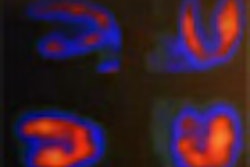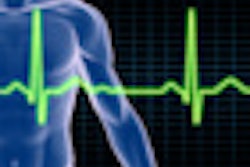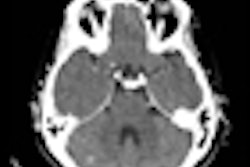TORONTO - Swiss researchers have developed a hybrid cardiac imaging method that combines coronary CT angiography (CTA) with SPECT myocardial perfusion imaging (MPI) to predict relevant coronary lesions with considerably less radiation dose and scanning time.
The study, presented Sunday at the SNM annual meeting, also shows that the technique produces high diagnostic accuracy. Lead author is Dr. Bernhard Herzog from the nuclear cardiology department at University Hospital Zurich in Switzerland.
While coronary CTA provides information comparable to coronary angiography, anatomical structures, such as a stenosis, "don't necessarily correspond very well with the underlying hemodynamic situation," said co-author Dr. Ronny Buechel at the SNM meeting. Coronary CTA also cannot determine whether a stenosis is "significant or not or hemodynamically significant or not."
While SPECT MPI can provide that information, the modality cannot target or pinpoint a possible lesion. "Against this background, it seems logical to fuse both techniques to get images that not only tell us whether there is a myocardial perfusion defect, but also where we find the responsible lesion," he said.
Hybrid's disadvantages
Until this research, hybrid imaging had two disadvantages, Buechel said. One drawback was the examination time, which for myocardial perfusion SPECT's standard protocols requires a patient to stay at a hospital for several hours. The second issue is higher radiation dose exposure (as much as 41 mSv, according to Buechel) for both coronary CTA and SPECT MPI, when compared to invasive coronary angiography.
Researchers prospectively enrolled 40 patients who were referred for coronary angiography due to suspected coronary artery disease. Each patient underwent coronary CTA and stress-only SPECT imaging.
To achieve low radiation dose exposure, the study's protocol for SPECT MPI included a stress-only exam and excluded a rest scan. By excluding the at-rest scan, researchers "omitted the waiting time between tracer application and image acquisition, which usually accounts for about 90 minutes," Buechel noted.
Half-dose protocol
At the same time, the researchers administered only half the usual technetium-99m tetrofosmin dose, which was made possible through a reconstruction algorithm that provides images at very low count rates, Buechel said. They also used prospective ECG triggering in coronary CTA scans for reduced radiation dose exposure.
The researchers used a 64-slice CT scanner (LightSpeed VCT XT, GE Healthcare of Chalfont St. Giles, U.K.) with a rotating gantry time of 350 msec and prospective ECG triggering for coronary CTA. If necessary, patients also received metoprolol to relegate heart rates to 63 beats per minute at rest to minimize the artifact effects from the ECG triggering.
A dual-head gamma camera (Ventri, GE Healthcare) was used to perform the one-day, stress-only SPECT MPI at half the standard Tc-99m tetrofosmin dose. Because imaging was conducted on standalone scanners, the researchers used software (CardIQ, GE Healthcare) to fuse the images from both datasets.
Imaging results
Hybrid imaging results revealed 21 hemodynamic-relevant lesions in 16 patients, compared with invasive coronary angiography, which detected 21 lesions in 15 patients.
"Hybrid cardiac imaging predicted the need for revascularization with a sensitivity and specificity of 100% and 96% [respectively] per patient," Buechel said. "Sensitivity and specificity was 90% and 97% [respectively] on a per-territory basis, yielding excellent negative predictive value and very good positive predictive value as well."
Positive and negative predictive values for hybrid imaging were 100% and 96%, respectively, for predicting the need of coronary revascularization.
Reduced radiation
Perhaps most important, the researchers noted that the hybrid results were achieved in less than 60 minutes of scan time and with mean effective radiation dose of only 4.7 mSv, compared with 8.7 mSv for invasive coronary angiography.
Coronary CTA accounted for approximately 2.1 mSv of radiation dose, another 1.1 mSv came from CT attenuation correction, and another 1.5 mSv came from the SPECT MPI scan.
Researchers concluded that the proposed hybrid cardiac imaging method is an "excellent noninvasive tool, not only for assessing the presence of coronary artery disease, but for predicting the need for revascularization as well," Buechel said. "It correctly identified 15 patients that needed revascularization, but due to its excellent negative predictive value, it also ruled out the need for revascularization."
He added that 24 patients "could have been safely deferred from a purely diagnostic invasive procedure at even lower radiation dose exposures than what was used during invasive coronary angiography."
As one possible limitation, because researchers did not include at-rest images, the study was unable to differentiate between a scar and ischemia in the cardiac images, Buechel noted.
By Wayne Forrest
AuntMinnie.com staff writer
June 15, 2009
Related Reading
Gated SPECT best indicator for cardiac events, April 13, 2009
ACC study: Most cardiac SPECT scans are appropriate, April 1, 2009
MRI, MDCT err in estimating cardiac functional parameters, February 20, 2009
Hybrid 3D echo/SPECT technique produces better coronary artery disease imaging, February 12, 2009
SPECT MPI predicts sudden cardiac death, September 26, 2008
Copyright © 2009 AuntMinnie.com




















